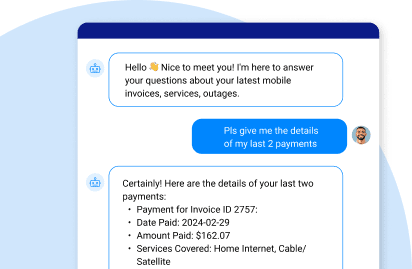RAG architecture enables real-time retrieval and integration of publicly available and privately held company data that enhances LLM prompts and responses.
What is Retrieval-Augmented Generation (RAG)?
While Large Language Models (LLMs) boast impressive capabilities, they have a critical Achilles' heel: factual accuracy.
The source of the problem? LLMs rely solely on the static data on which they were trained. And retraining these models to incorporate new information is a cumbersome, expensive, and resource-intensive process. Because of this, LLMs often provide untrue or misleading information, known as AI hallucinations – or generic, outdated outputs – instead of factual specific, and current answers.
Retrieval-Augmented Generation (RAG) elevates the relevance and reliability of LLM responses. Until recently, RAG was largely associated with the retrieval of unstructured data like textual information found in docs and stored in vector databases – because that’s what LLMs are trained on and used to. Today, innovative RAG models are adding structured data to the mix, resulting in dramatically improved response accuracy and AI personalization.
What does this look like, in action? When an LLM receives a user query, RAG intercepts the prompt and conducts a behind-the-scenes targeted information retrieval mission, extracting relevant details from up-to-date sources. The information retrieved is then combined with the user's original query, creating an enhanced prompt which is then fed into the LLM. This enables the framework to generate a response grounded in both its external knowledge and the freshly retrieved internal data.
With LLM grounding, RAG hallucinations are reduced while contextual relevance and factual accuracy are increased. It also offers users a layer of transparency, since the sources the LLM used to create its response can be easily accessed.
The Building Blocks of RAG Architecture
RAG integrates the power of information retrieval with the text generation capabilities of LLMs, offering an incredibly robust and reliable approach to generating accurate and personalized responses.
RAG architecture is comprised of 2 key components:
-
Retrieval
Active retrieval-augmented generation can be likened to running an information scanner tasked with finding relevant and reliable data based on a user query or prompt. It scours public and private knowledge bases – from the Internet to corporate documents and customer 360 or product 360 data – using advanced information retrieval algorithms to pinpoint the data that could enhance the response generation process.
-
Generation
A RAG LLM, pre-trained on massive datasets of text and code and then spot-trained on real-time company data, can better understand user context to answer questions in a much more personalized and comprehensive way.
RAG Architecture Step by Step
Retrieval-augmented generation is architected to tackle the limitations of LLMs by incorporating real-time retrieval of company information. Here's how it works:

-
User query
The user poses a question or issues a prompt to the LLM. This query could be anything from a factual inquiry ("What is the capital of France?") to a more open-ended request ("Write a marketing email for our new product launch.").
-
Data retrieval
The retrieval model intercepts the prompt and instantly scans all company data. Think of it as a high-powered search engine, specifically designed to sift through all accumulated structured and unstructured data. It identifies the most pertinent information related to the user's query.
-
Data-query fusion
The RAG system meticulously combines the retrieved data with the user's original query, to create a more focused, detailed, up-to-date, and informative prompt for the LLM.
-
Contextual prompt delivery
The newly constructed prompt, enriched with both the user's query and the retrieved data, is delivered to the LLM.
-
Response generation
The retrieval model creates an enriched prompt – augmenting the user’s original prompt with the additional contextual data – and inputs it to the generation model (LLM).
-
Output delivery
The LLM's response is sent to the user.
Challenges in RAG Architecture
While RAG architecture offers a powerful approach to generating more accurate and updated LLM responses, it's not without its hurdles. Here are some of the key challenges facing RAG architecture:
-
Data retrieval accuracy
The effectiveness of RAG is contingent on the performance of its retrieval model. If the model fails to identify the most relevant information, the LLM will be presented with an inaccurate or incomplete prompt – perhaps leading to false or nonsensical responses.
-
LLM integration
Fusing the retrieved data with the original user query into a well-structured prompt is crucial for effective response generation. Inconsistencies or poorly phrased prompts can confuse the LLM and hinder its ability to generate a coherent answer.
-
Source transparency
Unlike traditional search engines that provide a list of retrieved documents, some RAG systems operate as a black box. Without access to the information sources, users won’t be able to evaluate the trustworthiness or value of the information.
-
Cost effectiveness and scalability
As the complexity of the company data sources grows, the data retrieval process become more and more expensive in terms of time and resources. Plus, scaling RAG AI systems to handle massive datasets requires ongoing optimization.
-
Domain specificity
While RAG can leverage private company for domain-specific expertise, the LLM may not trained well enough that domain – leading to limitations in the depth and nuance of the generated responses.
Fuse Data and Queries with GenAI Data Fusion
K2view GenAI Data Fusion is the architecture that provides a complete RAG converational AI solution, grounding your generative AI apps with your enterprise data from any source in real time.
With the K2view RAG GenAI, your data is:
-
Ready for Generative AI
-
Provisionable in real-time and at scale
-
Complete and current
-
Governed, trusted, and safe
GenAI Data Fusion can:
-
Feed real-time data concerning a specific customer or any other business entity.
-
Mask sensitive or Personally Identifiable Information (PII) dynamically.
-
Be reused to handle data service access requests, or to suggest cross-sell recommendations.
-
Access enterprise systems through any combination of API, CDC, messaging, or streaming to aggregate data from many different source systems.
It powers your AI data apps to respond with accurate recommendations, information, and content – for use cases like RAG chatbots and more.
Discover K2view AI Data Fusion – the superior RAG tool.















